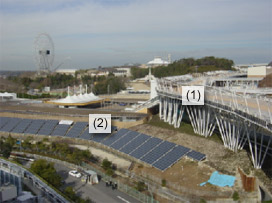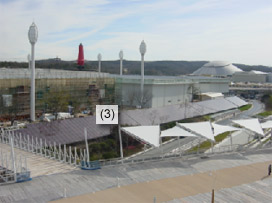Solar Power System
- Near West Gate -
Solar-electric power generation seems to have become familiar to children as well as adults, as a system for generating power from a natural energy source. An early example that comes to mind is the electronic calculator known as the “solar-powered calculator.” Solar panels have recently spread to wider applications, including home roofs and wristwatches.
Power-generating systems that use solar panels also demonstrate their performance at Expo 2005 Aichi.
On the Global Loop near Global Common 5, you will see a number of solar panels to your right and left. Large solar cell systems are installed near West Gate and the Spanish Pavilion, while small solar cell systems (the same as those installed at the Hitachi Group Pavilion) are installed on the outer fence of the Global Loop. These systems are classified into three types, according to differences in generation structure.
- Silicon single-crystal type: the system installed on the loop fence (generating capacity: 30 kW)
- Polysilicon type: the system installed near West Gate (generating capacity: 200 kW)
- Amorphous silicon type: the system installed near the Spanish Pavilion (generating capacity: 100 kW)
These systems have their respective pluses and minuses, and are used to meet specific needs. The relative features of these systems are as follows:
| Single-crystal type: | high conversion efficiency (13 - 20%), expensive |
| Polysilicon type: | resembles single-crystal type in both conversion efficiency and cost |
| Amorphous type: | low conversion efficiency (8 - 13%), inexpensive, high flexibility in terms of shape etc. |

(1) and (2) located near West Gate

(3) located near the Spanish Pavilion
The solar panels installed at the exhibition site of Expo 2005 Aichi are characterized, along with fuel cells, as one of the New Energy Plants and as part of the Demonstrative Project of Regional Power Grids with Various New Energies being carried out by the New Energy and Industrial Technology Development Organization (NEDO). These three types of solar panels together provide 330 kW in generating capacity, accounting for about 15% of the projected total electricity generated by the New Energy Plant. Most of the generated power is used at Japan Pavilion Nagakute.
Conversion Efficiency of Solar Panels
What is the relation between the solar panel size and amount of electricity generated?
The energy of sunlight striking the surface of the earth is approximately 1 kW per square meter under cloudless skies and with sunlight received perpendicularly. In panels, the energy is converted only partially to electricity due to conversion loss in the equipment, cloudy sky, reception of light at an angle, and dirt on the panel surface.
Conversion efficiency is determined by dividing the energy retrieved as electricity by the energy of the incident sunlight. At present, conversion efficiency is 10% to 20%. If conversion efficiency is 15%, to meet the power requirements of a home (assumed to be 3 kW), the required area of solar panels installed on the home roof is 20 m2. However, it is not always possible to generate 3 kW, as it is cloudy on some days.


